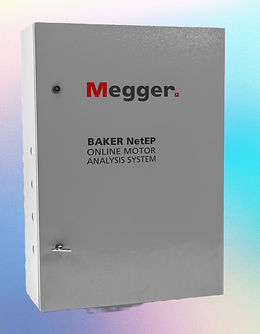
BAKER NETEP
Specifications and Capabilities
■ Continuously monitor over 100 parameters on up to 32 motors
■ Connect to motors using up to seven voltage busbars
■ Measurements include: Peak, RMS, THD, TD, CF for each V, I phase (and total), unbalance, power factor, input power and symmetrical components
■ Spectrum acquisition (three phases, voltage and current)
■ Time waveform acquisition
■ Torque time waveform, torque spectrum
■ Speed
■ Eccentricity
■ Power off
■ Percentage load
■ Percentage efficiency
■ Effective service factor
Identify predictive maintenance opportunities
■ Set alarm limits for parameters
■ View trends for parameters
Surveyor NetEP software capabilities
■ At-a-glance status status for all machines
■ View multiple NetEPs on a single screen
■ Dashboard view of 100+ measurements
■ Time waveform displays
■ Spectrum graphs with markers
■ Trend information
■ Machine, alarm, voltage bus editing
■ Torque time waveform and spectrum
■ Alarm acknowledgement
■ Data storage
Additional features
■ Local area network: Ethernet 802.4 standard 10/100/1000 Base T
■ AC input power: 110V-240V
■ Current transformers (CTs): 5A-2000A, CT signal operation up to 150 ft on CAT V cable, 25 kHz signal reception
■ Computers, data storage, and computer network connection are provided by the customer.
Server requirements
■ Server processing capacity: 2 GHz or faster CPU with 64-bit support and at least 2 cores
■ Memory: at least 2 GB; 4 GB or more recommended
■ Disk space: at least 10 GB of free disk space per NetEP
■ Operating system: Microsoft Windows 2012 or later; Windows 8 or later
■ Local area network connection: 10/100/1000 Base T
■ Database: Microsoft SQL or SQL Express
■ IP address: static
■ Power supply: UPS (uninterruptible power supply)
Megger Baker NetEP is a device used to continuously monitor and analyze the electrical status of rotating machines such as motors and generators. This device is designed to monitor the health of motors and generators and detect early-stage faults, especially in large industrial plants.
Its main features are:
1. *Continuous Monitoring:* NetEP can monitor the electrical parameters of motors 24/7. This prevents unexpected faults and allows more effective planning of maintenance processes.
2. *Comprehensive Tests:* The device can perform many electrical tests such as winding resistance, insulation resistance, capacitance and impedance.
3. *Data Analysis and Reporting:* The collected data is processed by the device's internal analysis software and detailed reports are presented to the user. In this way, information about trends and potential problems can be obtained.
4. *Remote Access:* NetEP can be monitored and managed from anywhere with the remote access feature. This increases operational efficiency.
As a result, Megger Baker NetEP plays a critical role in the situational monitoring of industrial motors and generators and the planning of pre-failure maintenance.
Monitoring capabilities
Power quality monitoring defines:
■ Incorrect tap settings on supply transformers
■ Poorly distributed single-phase loads
■ Overloaded (saturated) supply transformers
■ Missing or open power factor correction capacitors
■ Voltage surges/dips
Motor performance monitoring defines:
■ Thermal overload of motor and machine
■ Deterioration due to heat-related problems
■ Motor efficiency
■ Motor speed
■ Percent load
Current monitoring detects
■ Overloading
■ High resistance connections
■ Incorrect connections
■ Iron saturation
■ Incorrectly wound motors
Current/voltage spectrum monitoring defines:
■Saturation problems
■ Broken rotor bars
■ Eccentricity
Torque monitoring identifies:
■ Mechanical problems
■ Temporary overload
■ Mechanical imbalances
■ Bearing problems
■ Cavitation
■ Worn impellers